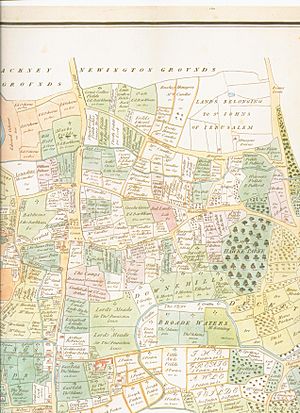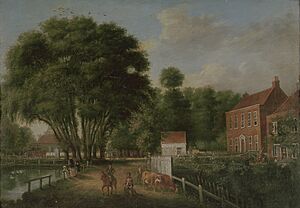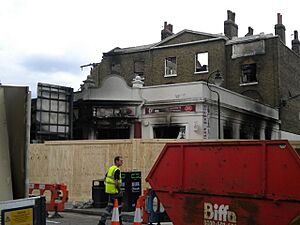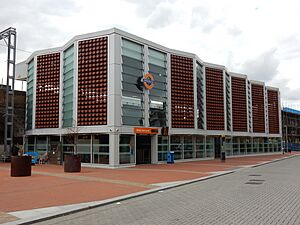Tottenham facts for kids
Quick facts for kids Tottenham |
|
|---|---|
 View of Tottenham |
|
| Population | 129,237 (2011 census) |
| OS grid reference | TQ33608950 |
| • Charing Cross | 6 mi (9.7 km) SSW |
| London borough | |
| Ceremonial county | Greater London |
| Region | |
| Country | England |
| Sovereign state | United Kingdom |
| Post town | LONDON |
| Postcode district | N15, N17 |
| Dialling code | 020 |
| Police | Metropolitan |
| Fire | London |
| Ambulance | London |
| EU Parliament | London |
| UK Parliament |
|
| London Assembly |
|
Tottenham is a town in North London, England. It is part of the London Borough of Haringey. Tottenham is about 6 miles (10 km) north-northeast of Charing Cross. It borders Edmonton to the north and Walthamstow to the east, across the River Lea.
The area grew quickly in the late 1800s. It became a place where many working-class families lived, especially after railways made it easy to travel. Tottenham has been home to the famous Premier League football team Tottenham Hotspur since 1882.
Tottenham is known for its many different cultures and people. After many people from the Caribbean moved there in the mid-1900s, it became one of the most diverse places in Britain. More recently, people from Africa, Asia, South America, and Eastern Europe have also made Tottenham their home. In 2011, about 129,237 people lived in Tottenham.
Contents
Tottenham's History
How Tottenham Got Its Name
Tottenham is thought to be named after a farmer called Tota. His small village was mentioned in the Domesday Book, a very old record from 1086. People believe 'Tota's hamlet' slowly became 'Tottenham'. The village was written as Toteham in the Domesday Book.
Early Days of Tottenham
People have lived in Tottenham for over a thousand years. It grew up along an old Roman road called Ermine Street, which is now part of the A10 road.
In 1086, when the Domesday Book was made, about 70 families lived in the area. Most of them were labourers working for the local lord. The River Lea forms the eastern border of Tottenham. This river was once the old boundary between Middlesex and Essex. It also marked the western edge of the Danelaw, an area controlled by Vikings.
From the Tudor period onwards, Tottenham became a popular spot for rich Londoners to relax. King Henry VIII visited Bruce Castle and hunted in Tottenham Wood. Tottenham was a quiet, countryside area until the 1870s.
Modern Tottenham Develops
In the late 1870s, new train lines made it cheap for workers to travel. This caused Tottenham's open fields to quickly change into affordable homes. Many working-class families moved here, making Tottenham a London suburb.
In 1894, Tottenham became an urban district. Then, in 1934, it became a municipal borough. On April 1, 1965, the borough of Tottenham joined with Hornsey and Wood Green to form the new London Borough of Haringey.
Important Events: Riots
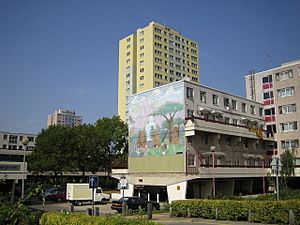
In 1985, there were riots near the Broadwater Farm Estate. This happened after a local resident, Cynthia Jarrett, died during a police search of her home. Tensions were already high between young black people and the police. During the riot, a police officer, Keith Blakelock, was killed. Many other people were also hurt.
More riots happened in Tottenham in 2011. These started after Mark Duggan, a 29-year-old man, was shot by police. On August 6, 2011, a protest march about his death turned into disturbances. Police cars, a bus, and several shops were attacked. Fires broke out, and some flats above shops were destroyed. The Prince of Wales and his wife visited the area to meet those affected by the riots.
Tottenham's Railway History
- The Northern and Eastern Railway opened in 1840. It had two stations in Tottenham: Tottenham and Marsh Lane.
- The Tottenham & Hampstead Junction Railway opened in 1868. South Tottenham station opened in 1871.
- The Stoke Newington & Edmonton Railway opened in 1872. It had stations at Seven Sisters, Bruce Grove, and White Hart Lane.
- The Palace Gates Line opened in Tottenham in 1878 but closed in 1965.
- The Victoria line of the London Underground opened in 1968.
Tottenham's Government
Local Representation in Parliament
Tottenham is a large part of the parliamentary constituency of Tottenham. This area elects one person to represent it in the UK Parliament. Since 1950, the area has mostly been represented by members of the Labour Party. The current MP is David Lammy, who became MP in 2000.
Tottenham's Geography
Tottenham is about 33 feet (10 meters) above sea level.
Parts of Tottenham
Because Tottenham has been a borough for a long time, the name "Tottenham" is still used for the whole area that the old borough covered. This includes the N17 postcode area and part of N15. However, people have different ideas about what counts as Tottenham today. Many think of Tottenham as most of the N17 postcode area.
- North Tottenham: This area runs along Tottenham High Road from the Edmonton border. It includes areas like Little Russia and Northumberland Park.
- Central Tottenham: This part includes Bruce Grove, Tottenham Green, and Tottenham Hale areas. It also has Tottenham Hale station and a retail park.
- West Tottenham: To the west are Broadwater Farm and the Tower Gardens Estate.
- South Tottenham: This area is further along the A10 road and includes South Tottenham and Seven Sisters.
Areas Near Tottenham
People of Tottenham
In 2011, MP David Lammy stated that Tottenham had one of the highest unemployment and poverty rates in London and the UK.
Different Cultures in Tottenham
Tottenham has a very diverse population with many different ethnic groups. It has one of the largest populations of Afro-Caribbean people in Britain. These groups were among the first immigrants to settle here. More recently, people from Africa, Asia, and Eastern Europe have also moved to Tottenham. The Seven Sisters area has the largest number of Jewish residents in Haringey.
In the 2011 UK Census, the main ethnic groups in the Tottenham area were:
- 27.7% Other White
- 26.7% Black
- 22.3% White British
- 10.7% Asian
- 12.6% Other/Mixed
Famous Places in Tottenham

- All Hallows Church – This is the oldest building in Haringey, dating back to Norman times. It was Tottenham's first parish church for over 700 years.
- Broadwater Farm – A housing estate built in 1967. It was the site of the Broadwater Farm riot in 1985.
- Bruce Castle, Lordship Lane – This historic manor house dates from the 1500s. It was named 'Bruce Castle' after Robert the Bruce's family, who were lords of the manor long ago. It was once a school and is now a local history museum. Sir Rowland Hill, who introduced the Uniform Penny Post, lived here.
- 7 Bruce Grove – This building has a blue plaque for Luke Howard, who was known as the 'Father of Meteorology'. He named the clouds in 1802.
- High Cross – A monument built between 1600 and 1609. It stands where an older Christian cross, or possibly a Roman marker, once stood.
- Tottenham Marshes – These are part of the Lee Valley Regional Park, offering green space.
- Tottenham Town Hall – A beautiful Edwardian building that is listed as a Grade II historic building.
Getting Around Tottenham
London Underground (Tube)
The Victoria line of the London Underground goes through Tottenham. It stops at Seven Sisters and Tottenham Hale. This line connects Tottenham to places like Walthamstow, the West End, and Brixton.
National Rail Trains
Tottenham is served by two train companies:
- London Overground trains run from Seven Sisters, Bruce Grove, and White Hart Lane stations. These trains go to Liverpool Street, Chingford, Cheshunt, and Enfield Town. The Gospel Oak to Barking line also serves South Tottenham.
- Greater Anglia trains stop at Tottenham Hale and Northumberland Park. These trains go to Liverpool Street, Stratford, Cheshunt, Hertford East, and Bishops Stortford. Tottenham Hale also connects to Stansted Airport and Cambridge.
Buses
Many London Bus routes serve Tottenham, making it easy to travel around. Some routes include 41, 76, 149, 243, and 259.
Cycling
Tottenham is connected to both London and national cycle networks. This means there are good paths for cycling for fun or for commuting.
- National Cycle Route 1 (NCR 1) runs through Tottenham along the River Lea towpath.
- Cycle Superhighway 1 (CS1) starts in Tottenham near the Tottenham Hotspur Stadium. It runs on quieter roads towards the City of London.
- Quietway 2 (Q2) goes around Tottenham's south-eastern edge, using towpaths and quiet streets.
- EuroVelo 2 (The Capitals Route), a long international cycle route, also follows NCR 1 through Tottenham.
Sports in Tottenham

Tottenham is famous for being the home of the Premier League football club Tottenham Hotspur. From 1899 to 2017, their home ground was White Hart Lane. This stadium was then taken down to build a new, bigger stadium called the Tottenham Hotspur Stadium on the same site. The new stadium opened on April 3, 2019. For a while, the club played their home games at Wembley while the new stadium was being built.
Tottenham also has two other football clubs: Haringey Borough F.C. and Park View F.C..
Tottenham in Popular Culture
Tottenham cake is a type of sponge cake that is baked in large trays. It is usually covered in pink icing, or sometimes jam, and can have shredded coconut on top. The exact origin of Tottenham cake is not fully clear. Some say it was first sold by a baker named Henry Chalkley in 1901. The pink colour originally came from mulberries that grew at the Tottenham Friends burial ground. This cake was once a local invention in north London. Later, it was made by larger bakeries. The cake was even featured on The Great British Bake Off TV show in 2013.
See also
 In Spanish: Tottenham para niños
In Spanish: Tottenham para niños



